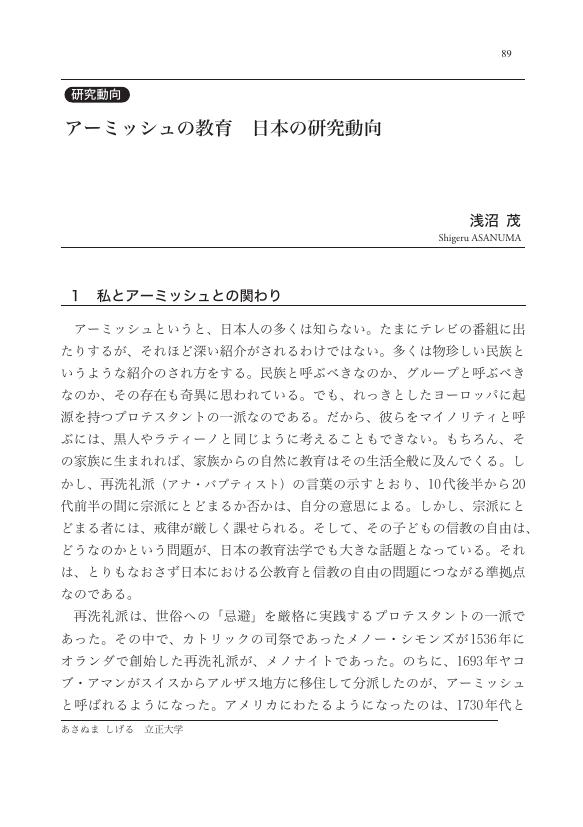3 0 0 0 OA アメリカ合衆国の高等教育と連邦政府 —間接的関与の在り方
- 著者
- 野崎 与志子
- 出版者
- アメリカ教育学会
- 雑誌
- アメリカ教育研究 (ISSN:24339873)
- 巻号頁・発行日
- vol.30, pp.112-126, 2020-02-10 (Released:2022-03-30)
1 0 0 0 OA アーミッシュの教育日本の研究動向
- 著者
- 浅沼 茂
- 出版者
- アメリカ教育学会
- 雑誌
- アメリカ教育研究 (ISSN:24339873)
- 巻号頁・発行日
- vol.31, pp.89-109, 2021-02-28 (Released:2022-03-29)
1 0 0 0 OA 米国の人種統合計画におけるカラー・コンシャスからカラー・ブラインドへの変容
- 著者
- 黒田 友紀
- 出版者
- アメリカ教育学会
- 雑誌
- アメリカ教育学会紀要 (ISSN:13406043)
- 巻号頁・発行日
- vol.27, pp.15-27, 2016-10-20 (Released:2023-01-30)
The purpose of this paper is to examine the transformation of desegregation/integration plans from "color-conscious" to "color-blind" in the United States.Current issues of equality in education are growing more and more complicated. Progress was made by Brown v. Board of Education in 1954, the Civil Rights Act in 1964, and the Elementary and Secondary Education Act(ESEA)in 1965, expanding equal opportunities in education for people of color, particularly black children. However, trends in population and racial/ethnic components continue to change, and some cities have seen increases in the Hispanic/Latino population in recent years.Furthermore, color-blind ideology has spread in the United States. Because color-blind ideology is seen by some as an ideal, seeming to indicate equal treatment of all people, both right and left use the term. However, we should be careful in our dealings with this concept, as "color- blindness" has potential to hide and exacerbate inequality.With respect to desegregation/integration, white students filed a lawsuit against the affirmative action admissions program in universities, claiming it to be "reverse discrimination" against white people. They requested equal opportunity for all, referring to the equal protection clause of the Fourteenth Amendment. Some Supreme Court decisions concerning desegregation plans have additionally affected and narrowed the scope of desegregation/integration. In elementary and secondary public education, Parents Involved in Community Schools v. Seattle School District No.1; Meredith and McDonald v. Jefferson County Board of Education et al., U.S. 127 S. Ct. 2738(PICS)had a huge impact on desegregation/integration plans in United States public schools, specifically outlawing any desegregation/integration plan giving priority mainly based on race. The U.S. Department of Justice and Department of Education illustrated and suggested guidelines on voluntary use of race—that is, a race-neutral strategy for achieving diversity. For instance, Cambridge’s controlled choice plan had been recognized since the 1980s as one of the better integration plans based on race and other factors; from 2002 on, factors including socio-economic status, race, and gender were used in controlled choice. However, this plan was revised in 2013, as the use of race as a criterion was forbidden.Color-blind or race-neutral educational policy has become widespread in pursuit of equality for all children. However, this strategy could in fact support rights for white people rather than people of color. We should thus examine the real situation of all children, and scrutinize whether inequality and(re)segregation has in fact grown worse than before.
- 著者
- 阿曽沼 明裕
- 出版者
- アメリカ教育学会
- 雑誌
- アメリカ教育研究 (ISSN:24339873)
- 巻号頁・発行日
- vol.30, pp.65-82, 2020-02-10 (Released:2022-03-30)
- 参考文献数
- 12
It is often said that Japanese higher education institutions should be more functionally- differentiated within the entire higher education system in order to make effective use of the limited resources in the context of the shrinking higher education population and tight government fiscal policy. The issues of the functional differentiation of higher education institutions are highly related to how the government allocates financial resources to higher education institutions. Japanese scholars and government administrators often look at and refer to the diversity of the American higher education system, especially the famous “Carnegie Classification of Institutions of Higher Education”. They have also focused on the US federal research grants system and financial aids to students. However, we have not yet got the total image of the flows of government funds to US higher education institutions. This article examines the scale and structure of flows of the government funds by using the IPEDS (The Integrated Postsecondary Education Data System) in order to understand the conditions and backgrounds of the effective functional differentiated higher education system.In the US system, there are mainly three factors which make the understanding of the flows of government funds difficult. Firstly, there are several governments responsible for funding higher education institutions: federal government, state governments, and local governments. Secondly, there are several ways of funding: appropriations, grants and contracts, and student aids. Thirdly, there are various types of higher education institutions; public, private for-profit, and private not-for-profit in addition to the functionally differentiated institutions such as research universities, doctoral universities, master’s colleges & universities, baccalaureate colleges, associate’s colleges, special focus institutions and so on. We examine the flows of governmental funds based on the analysis of relationship between these three factors.
1 0 0 0 OA アメリカ・ナショナリズムの展開と「よい市民」の形成
- 著者
- 宮本 健市郎
- 出版者
- アメリカ教育学会
- 雑誌
- アメリカ教育研究 (ISSN:24339873)
- 巻号頁・発行日
- vol.30, pp.1-11, 2020-02-10 (Released:2022-03-30)

